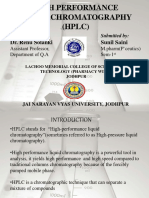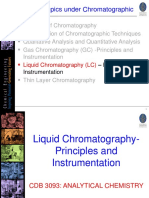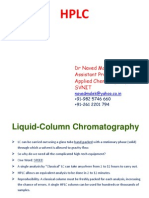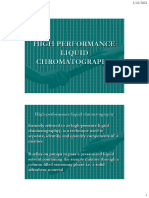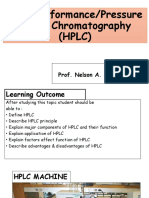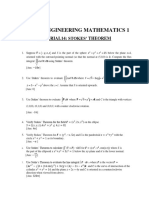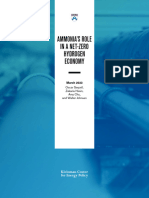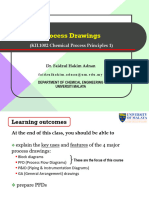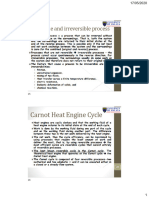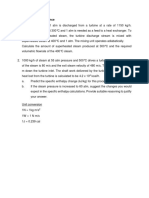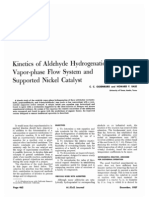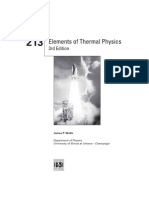23/12/2023
High-performance liquid
chromatography (HPLC)
What is HPLC ?
High-performance liquid chromatography (HPLC), formerly referred to
as high-pressure liquid chromatography, is a technique in analytical
chemistry used to separate, identify, and quantify each component in
a mixture.
HPLC separates compounds dissolved in a liquid sample and allows
qualitative and quantitative analysis of what components and how
much of each component are contained in the sample.
1
� 23/12/2023
Basic components of the HPLC
HPLC instruments consist of a reservoir of mobile phase, a pump, an
injector, a separation column, and a detector.
Components in HPLC
2
� 23/12/2023
Terms and its definition
The Pump
The development of HPLC led to the development of the pump system.
The pump is positioned in the most upper stream of the liquid
chromatography system and generates a flow of eluent from the solvent
reservoir into the system.
High-pressure generation is a “standard” requirement of pumps besides
which, it should also to be able to provide a consistent pressure at any
condition and a controllable and reproducible flow rate.
3
� 23/12/2023
Injector
An injector is placed next to the pump.
The simplest method is to use a syringe, and the sample is introduced to
the flow of eluent.
The most widely used injection method is based on sampling loops.
The use of the autosampler (auto-injector) system is also widely used
that allows repeated injections in a set scheduled-timing.
Column
The separation is performed inside the column.
The recent columns are often prepared in a stainless steel housing, instead of
glass columns.
The packing material generally used is silica or polymer gels compared to
calcium carbonate.
Most column housing is made of stainless steel since stainless is tolerant
towards a large variety of solvents.
4
� 23/12/2023
Detector
Separation of analytes is performed inside the column, whereas a
detector is used to observe the obtained separation.
The composition of the eluent is consistent when no analyte is present.
While the presence of analyte changes the composition of the eluent.
What detector does is to measure these differences.
There are different types of detectors available:
i. UV/Vis Detectors
ii. Photodiode Array (PDA) Detectors
iii. Fluorescence Detectors
iv. Refractive Index Detectors
v. Evaporative Light Scattering Detectors
vi. Mass Spectrometric Detectors
UV/Vis Detectors
Responds to chromophoric analytes in the range 190 – 800nm
Single wavelength monitoring
Good for the majority of organic analytes
10
5
� 23/12/2023
Refractive Index Detectors
Considered a universal detector for all analytes
Comparatively insensitive
Not compatible with gradient elution
11
How does HPLC works?
12
6
� 23/12/2023
Summary of process
The sample mixture to be separated and analyzed is
introduced, in a discrete small volume into the stream
of mobile phase percolating through the column
The components of the sample move through the
column at different velocities, which are a function of
specific physical interactions with the adsorbent (also
called stationary phase)
The velocity of each component depends on its
chemical nature, on the nature of the stationary phase
(column) and on the composition of the mobile phase.
13
Separation mechanism
HPLC can separate and detect each compound by the difference
of each compound's speed through the column. The main principal
of separation is adsorption.
Many different types of columns are available as shown below. They
are usually filled with adsorbents varying in particle size, porosity, and
surface chemistry. Sorbent particles may be hydrophobic or polar in
nature.
14
7
� 23/12/2023
Phases for HPLC
There are two phases for HPLC:
i. Mobile phase - is the liquid that dissolves the target compound.
ii. Stationary phase - is the part of a column that interacts with the target
compound.
In the column, the stronger the affinity (e.g.; van der waals force)
between the component and the mobile phase, the faster the
component moves through the column along with the mobile phase.
On the other hand, the stronger the affinity with the stationary phase, the
slower it moves through the column.
15
Example
16
8
� 23/12/2023
Example
Yellow component has a strong affinity with the mobile phase and moves
quickly through the column, while the pink component has a strong affinity
with the stationary phase and moves through slowly.
17
Types of HPLC
18
9
� 23/12/2023
Normal phase
In this column type, the stationary phase is polar (hydrophilic) and the
mobile phase is non-polar (hydrophobic).
The retention is governed by the interaction (such as hydrogen-
bonding or dipole-dipole) between the polar parts of the stationary
phase and solute.
19
Reverse phase
The stationary phase is non-polar and the mobile phase is polar.
Examples of nonpolar are hydrocarbons, waxy liquids, or bonded
hydrocarbons (such as C18, C8, etc.) and the solvents are polar
aqueous-organic mixtures such as methanol-water or acetonitrile-water.
20
10
� 23/12/2023
Size exclusion
In size exclusion HPLC, the column is consisted of substances which have
controlled pore sizes and is able to be filtered in an ordinarily phase
according to its molecular size.
Small molecules penetrate into the pores within the packing while larger
molecules only partially penetrate the pores. The large molecules elute
before the smaller molecules.
21
Ion exchange
In this column type the sample components are separated based upon
attractive ionic forces between molecules carrying charged groups of
opposite charge to those charges on the stationary phase.
Separations are made between a polar mobile liquid, usually water
containing salts or small amounts of alcohols, and a stationary phase
containing either acidic or basic fixed sites.
22
11
� 23/12/2023
23
Isocratic vs. Gradient Elution Modes
Isocratic Elution
• A single composition of solvents is used for the duration of the separation
• Steps must be taken to periodically flush the column at higher solvent strength
to clean it of intractable materials that build up from sample injections
Gradient Elution
• The composition of solvents is changed either continuously or stepwise
• In general, peaks are sharper throughout the chromatogram when compared
to isocratic elution
• Some separations may be achieved which are not possible using isocratic
elution
• Chromatogram run times may be shorter when compared to isocratic elution
24
12
� 23/12/2023
Modes of High Performance Liquid
Chromatography
Types of Compounds Mode Stationary Mobile Phase
Phase
Neutrals Reversed C18, C8, C4 Water/Organic
Weak Acids Phase cyano, amino Modifiers
Weak Bases
Ionics, Bases, Acids Ion C-18, C-8 Water/Organic
Pair Ion-Pair Reagent
Compounds not Normal Silica, Amino, Organics
soluble in water Phase Cyano, Diol
Ionics Inorganic Ions Ion Anion or Cation Aqueous/Buffer
Exchange Exchange Counter Ion
Resin
High Molecular Weight Size Polystyrene Gel Filtration-
Compounds Exclusion Silica Aqueous
Polymers Gel Permeation-
Organic
25
Sample Preparation
26
13
� 23/12/2023
Filtration
Particulates should be removed from liquid samples prior to injection because of
their adverse effect on column lifetime. In addition, particulates can also affect
HPLC hardware (e.g. flow lines, rotary injection valves, and inlet frits) and GC
inlets, columns, and detectors. The most common methods for removing
particulates from the sample are filtration, centrifugation, and sedimentation.
27
Preparation of Mobile Phase
28
14
� 23/12/2023
How to Read a Chromatogram
Another sample (sucrose) is
Sample glucose is tested
tested also.
29
This is the results of unknow sample.
How to interpret the peaks?
The remaining two peaks are still
unknown as there is no standard
to compare. For detection of
peaks, it is important to have
standards.
30
15
� 23/12/2023
Chromatogram and Related Terms
The obtained plot is more like the shape of a
bell rather than a triangle. This shape is called
a “peak”.
Retention time (tR) is the time interval
between sample injection point and the apex
of the peak.
The required time for non-
retained compounds (compounds with no
interaction for the stationary phase) to go
from the injector to the detector is called the
dead time (t0).
The peak height (h) is the vertical distance
between a peak's apex and the baseline, and
the peak area (A) colored in light blue is the
area enclosed by the peak and baseline.
31
Retention time
Is measured from the time at which the sample is injected to the point at which the
display shows a maximum peak height for that compound.
Different compounds have different retention times. For a particular compound, the
retention time will vary depending on:
• the pressure used (because that affects the flow rate of the solvent)
• the nature of the stationary phase (not only what material it is made of, but also
particle size)
• the exact composition of the solvent
• the temperature of the column
That means that conditions have to be carefully controlled if you are using retention
times as a way of identifying compounds.
32
16
� 23/12/2023
HPLC to determine concentration
33
Let’s try
Find the concentration of compound X
34
17
� 23/12/2023
Answer
Concentration of compound X = 207.757 mg/l
35
Benefits of HPLC
Provides data
Controls and automates management, security
chromatography features, and reporting Powerful and adaptable
instrumentation and instrument
validation.
Increases productivity by
managing all the areas of
analysis - from sample to
instrument, and from Affordable
separation to reporting
results.
36
18
� 23/12/2023
Applications of HPLC
37
Difference between HPLC and GCMS
38
19
� 23/12/2023
Operating HPLC
39
Thank You
40
20



